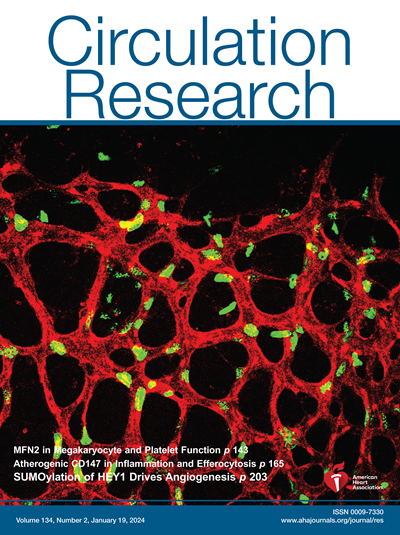Habitual Exercise Modulates Neuroimmune Interaction to Mitigate Aortic Stiffness.
IF 16.5
1区 医学
Q1 CARDIAC & CARDIOVASCULAR SYSTEMS
引用次数: 0
Abstract
BACKGROUND Exercise augments hemodynamic shear to activate mechano-sensitive molecular transducers in the vascular endothelium. Recently, the central nervous system has been reported to mediate neuroimmune interaction in the aortic adventitia (AA). Whether exercise modulates the sympathetic nerve interaction with the immune cells to mitigate aortic stiffness remains unknown. METHODS AND RESULTS Four weeks of Ang II (angiotensin II) infusion to C57BL/6 mice increased neural activation to increase the expression of TH (tyrosine hydroxylase) for sympathetic nerve axons and norepinephrine levels along with the colocalization of synapsin and β2-AR (β2-adrenergic receptor)-positive macrophages in the AA. This Ang II-mediated sympathetic nerve and macrophage interaction activated fibroblasts to increase vascular fibrosis and arterial pulse wave velocity. Sympathetic denervation with celiac ganglionectomy or 6-hydroxydopamine treatment abrogated Ang II-mediated TH+, AA thickness, and pulse wave velocity. Single-cell RNA sequencing analyses of the AA revealed that Ang II increased the circulating monocyte-derived macrophages (Ccr2+CD80) but reduced the resident macrophages (Lyve1+CD163). Gene ontology analysis of differentially expressed genes unveiled that voluntary wheel running mitigated Ang II-mediated increase in Ccr2+CD80 macrophages, cytokine-mediated signaling pathways in macrophages, and extracellular matrix deposition in fibroblasts. Macrophage depletion with Ki20227 (colony stimulating factor 1 receptor inhibitor) reduced Ang II-mediated synapsin+ macrophages. Using the Ccr2 knock-in (Ccr2gfp)/knock-out (Ccr2KO) mice, we observed that Ang II-mediated increases in Ccr2+ macrophages were expressed in Ccr2gfp mice but were absent in Ccr2KO mice. Also, Ang II-induced increases in synapsin expression, neighboring Ccr2+ cells, AA thickness, and pulse wave velocity were reduced in Ccr2KO mice. Both Ki20227 and Ccr2KO reduced the Ang II-mediated increase in TH levels. Furthermore, voluntary wheel running-mediated reduction in vascular fibrosis and aortic stiffness were mitigated by a β2-AR agonist, terbutaline, indicating β2-AR in neuroimmune modulation. CONCLUSIONS Exercise mitigates Ang II-mediated sympathetic axon interaction with the circulating monocyte-derived macrophages in the AA to attenuate vascular fibrosis and aortic stiffness.习惯性运动调节神经免疫相互作用以减轻主动脉僵硬。
运动增强血流动力学剪切,激活血管内皮中的机械敏感分子换能器。最近,有报道称中枢神经系统介导主动脉外膜(AA)的神经免疫相互作用。运动是否调节交感神经与免疫细胞的相互作用以减轻主动脉僵硬仍不清楚。方法与结果C57BL/6小鼠血管紧张素ⅱ(Ang II)输注4周后,神经活性增加,交感神经轴突酪氨酸羟化酶(TH)表达增加,去甲肾上腺素水平升高,突触素和β2-AR (β2-肾上腺素受体)阳性巨噬细胞在AA区共定位。这种Ang ii介导的交感神经和巨噬细胞相互作用激活成纤维细胞,增加血管纤维化和动脉脉搏波速度。交感神经断行腹腔神经节切除术或6-羟多巴胺治疗可消除Ang ii介导的TH+、AA厚度和脉波速度。AA的单细胞RNA测序分析显示,Ang II增加了循环单核细胞来源的巨噬细胞(Ccr2+CD80),但减少了常驻巨噬细胞(Lyve1+CD163)。差异表达基因的基因本体论分析显示,自主跑轮减轻了Ang ii介导的巨噬细胞Ccr2+CD80的增加、巨噬细胞中细胞因子介导的信号通路和成纤维细胞的细胞外基质沉积。Ki20227(集落刺激因子1受体抑制剂)减少巨噬细胞,减少Ang ii介导的突触素+巨噬细胞。使用Ccr2敲入(Ccr2gfp)/敲除(Ccr2KO)小鼠,我们观察到Ang ii介导的Ccr2+巨噬细胞的增加在Ccr2gfp小鼠中表达,而在Ccr2KO小鼠中不存在。在Ccr2KO小鼠中,Ang ii诱导的突触素表达、邻近Ccr2+细胞、AA厚度和脉冲波速度的增加也减少了。Ki20227和Ccr2KO均可降低Ang ii介导的TH水平升高。此外,β2-AR激动剂特布他林减轻了自主轮跑介导的血管纤维化和主动脉僵硬的减轻,表明β2-AR在神经免疫调节中起作用。结论:运动可减轻Ang ii介导的交感轴突与AA循环单核细胞源性巨噬细胞的相互作用,从而减轻血管纤维化和主动脉僵硬。
本文章由计算机程序翻译,如有差异,请以英文原文为准。
求助全文
约1分钟内获得全文
求助全文
来源期刊

Circulation research
医学-外周血管病
CiteScore
29.60
自引率
2.00%
发文量
535
审稿时长
3-6 weeks
期刊介绍:
Circulation Research is a peer-reviewed journal that serves as a forum for the highest quality research in basic cardiovascular biology. The journal publishes studies that utilize state-of-the-art approaches to investigate mechanisms of human disease, as well as translational and clinical research that provide fundamental insights into the basis of disease and the mechanism of therapies.
Circulation Research has a broad audience that includes clinical and academic cardiologists, basic cardiovascular scientists, physiologists, cellular and molecular biologists, and cardiovascular pharmacologists. The journal aims to advance the understanding of cardiovascular biology and disease by disseminating cutting-edge research to these diverse communities.
In terms of indexing, Circulation Research is included in several prominent scientific databases, including BIOSIS, CAB Abstracts, Chemical Abstracts, Current Contents, EMBASE, and MEDLINE. This ensures that the journal's articles are easily discoverable and accessible to researchers in the field.
Overall, Circulation Research is a reputable publication that attracts high-quality research and provides a platform for the dissemination of important findings in basic cardiovascular biology and its translational and clinical applications.
 求助内容:
求助内容: 应助结果提醒方式:
应助结果提醒方式:


